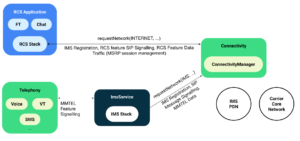introduction
As we move deeper into the digital age, Companion Device Manager has become an indispensable tool for countless users around the world. But despite its widespread use, its ability to hide spyware cannot be discounted. It is important that these concerns are known to all users.
To understand partner device managers
Equipment monitors included in particular are sophisticated tools designed to operate and simplify most devices. Major platforms such as Windows and Android have adopted them, offering significant benefits in terms of managing devices and improving the user experience. But their broad networks and capabilities allow them to boldly step into potential security threats.
For example, the Companion Device Manager can monitor any of your fitness trackers, smartwatches, or Bluetooth devices for that purpose. Providing unmatched convenience, it also opens potential doors for spyware and other unwanted activities.
What is spyware?
Spyware, in layman’s terms, is software that is nefariously designed to store user information and be stolen without consent. It lurks in the shadows of your device, collecting information about your habits, preferences and personal information.
There are many types of spyware out there—each with different functionality. Adware that will track your online behavior, Trojans that exploit security gaps, and cookies that track your digital footprint, to name a few.
Spyware usually doesn’t tag as just one. It often comes with legitimate software or sneaks in via an insecure website or email. His entrant is always tricky, making this a formidable opponent.
Can Companion Device Managers get Spyware?
Yes, but not as straightforward as it sounds.
While a possible weakness cannot be ruled out, empirical evidence and research do not suggest a major problem. There have been no repeated incidents or cases where Companion Device Managers have been infected with spyware.
Why target partner device managers? Their immense control over other devices makes them an incredible prospect for hackers. However, it’s also important to note that operating systems take serious preventive measures to prevent such attempts, making Companion Device Manager less susceptible to becoming a spyware hub
Surely everyone should have concerns, but it’s also a topic that requires nuanced understanding — the interface between partner device administrators and spyware is complex, costly, and far from a perfect solution.
How Spyware Can Affect Your Privacy and Security
Spyware can negatively impact the performance of your device. It runs stealthily in the background, steals valuable computer resources, and causes slowdowns and even crashes.
In addition to the annoyance of a slow device, spyware poses a serious threat to privacy and sensitive information. Imagine financial information, email content, passwords, and even your digital identity, all exposed and accessible. It really is an open book for the negative actor.
This breach of security and privacy has real consequences. Identity theft can ruin your credit score. Identity theft can cost companies millions of dollars. These are not fictional stories but spyware that poses a real threat to the world.
10 Shocking Truths About Companion Device Managers and Spyware
- Spyware is everywhere – Studies have shown that 90% of home PCs have some form of spyware installed.
- Undetectable – Many types of spyware are optimized to evade antivirus software.
- Economic Losses – Cybersecurity Ventures predicts that by 2021, cybercrime will cost the world $6 billion a year.
- Selling data – Personal data stolen by spyware is often sold on the dark web.
- Slow response – It usually takes an average of 191 days to detect a data breach.
- Spyware infections – Every day, 33,000 websites are infected with some form of spyware.
- Spyware Production – About 1 million new malware threats are created every day.
- Spyware Versatility – Spyware can infect any device including smartphones, laptops and even smart TVs.
- Legal Use: Some spyware programs are legally used for parental control and are monitored by the company.
- Anonymity – Perpetrators behind spyware attacks are almost never prosecuted
The implications of these truths range from invasion of personal privacy to significant financial loss. The statistics are a wake-up call for the need for Companion Device Managers to be strictly secure.
Tips to protect your companion device manager from Spyware
Taking specific preventative measures can reduce the risk of your partner’s device manager becoming the target of spyware:
- Update software: Regular system and software update patch vulnerabilities exploited by spyware.
- Download wisely: Just download apps from trusted sources to avoid spyware stacks.
- Use a firewall: A strong firewall can prevent many types of spyware from infecting your device.
- Regular scans: Regular scans with reliable antivirus software can detect and remove potential spyware.
- Email Savvy: Avoid opening suspicious emails and clicking unverified links.
By following these steps and being vigilant, you can create a formidable barrier between your Companion Device Manager and potential spyware threats.
To detect spyware symptoms in partner device administrators
Identifying spyware symptoms in partner device managers can be a daunting task. However, some common symptoms can indicate infection:
- Decreased performance: If your device suddenly lags or crashes frequently, spyware may be probing.
- Unexpected ads: Pop-ups, unsolicited ads, or redirected browsers may indicate adware, some form of spyware.
- Battery drain: Persistent spyware running in the background can quickly drain your battery.
- Data tampering: A sudden spike in data usage could be an indication that a spyware program is sending information from your device.
Staying alert and monitoring your device for these symptoms will help you catch the infection early.
What to do if you suspect your partner’s equipment manager is infected
If you suspect your Companion Device Manager is infected, follow these steps:
- Isolate the device: Disconnect from the Internet and other devices to prevent further spread of the virus.
- Use antivirus software: Use a popular antivirus tool to scan the device and remove the spyware infection.
- Update and Reset: Update your software to patch vulnerabilities. You can restore it to the factory setting if needed.
- Seek professional help: If the infection persists, consider talking to a doctor.
Avoiding future spyware disasters
Consider these tips for maintaining a secure and spyware-free Companion Device Manager:
- Regular software updates: Software updates reduce vulnerabilities that can be exploited by spyware.
- Routine monitoring: Monitor business processes, account usage, and other potential spyware indicators.
- Cybersecurity education: Stay up-to-date with the latest cybersecurity threats and solutions.
By taking these proactive measures, you can greatly reduce the chances of your Companion Device Manager being infected with spyware.
conclusion
In conclusion, it seems clear that partner device managers are not inherently spyware, but if left unprotected, malicious software can be installed The risks of spyware – from compromised device performance – were examined to serious privacy and security risks – thoroughly, and highlighted the need for strong preventative measures
We also uncovered shocking truths about the ubiquity and impact of spyware, which we hope will serve as an eye-opener to the importance of cybersecurity. Knowing the early signs of infection, recognizing the reactions to suspected infection, and understanding preventive measures play an important role in maintaining a safe companion device controller.
Let’s emphasize a key point made through this talk: user vigilance and proactive security measures are paramount. Protecting our devices, our privacy and, more broadly, the connected digital landscape is a collective responsibility. It is therefore incumbent upon every individual to take the necessary precautions and understand that cybersecurity is not an option, but a necessity in our increasingly digitized world.
Your companion device manager is an awesome tool, but it’s up to you to make sure it acts as an ally, not as a prop for unintended digital adversaries. We strive to be more informed, prepared and safer. Because the adage in cybersecurity is true: prevention is indeed better than cure.








More Stories
SCPM Client vs. Traditional Methods: Revolutionizing Supply Chain Performance
How To Delete Cash App Account Hassle-Free: A Step-By-Step Guide
Stopwatt Reviews: Scam or Legit? A Detailed Analysis